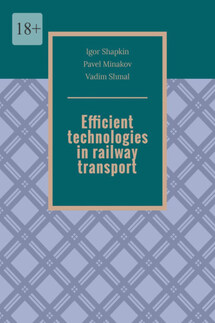Efficient technologies in railway transport - страница 4
The result of the work carried out will be the achievement of the target parameters set by the holding’s Development Strategy until 2030.
The state is the sole shareholder of JSC “Russian Railways”, and, of course, the solution of state tasks is the main priority. At the same time, the company, as a commercial organization, is obliged to work profitably. It should have resources for development, opportunities to offer customers new attractive transport products.
To solve these problems, a program was developed to optimize operational and investment activities. The achievement of the program parameters is ensured through the implementation of measures aimed at improving the efficiency of the use of traction rolling stock, the introduction of landfill technologies, increasing the level of routing, the quality of work of marshalling yards, increasing labor productivity, improving procurement activities, etc. Particular attention is paid to the issues of reducing unproductive losses arising at the junctions of interaction between production units. Here, the company uses both technological and economic incentive measures, for example, through a system for monitoring the execution of work orders between production units.
The company will have to solve the issues of further efficiency improvement through the introduction of new technologies, technical and management solutions in the organization of the transportation process. Reserves are actively used in expanding the possibilities of combining professions, in organizing the work of locomotive crews in one person. The quality of repair of infrastructure facilities is improving, including through the use of progressive repair methods, tightening the conditions for commissioning. Serious attention is paid to the efficiency of using low-intensity lines.
The main principle is that every ruble spent and invested should benefit and work for the efficiency of the industry.
The implementation of the tasks set by the Structural Reform Program has shown that the company is able to develop and adapt to the needs of the market. This is demonstrated by the analysis of the performance indicators of Russian and foreign railways. The load load on the network of JSC “Russian Railways” is the second in the world after China, and it is almost 9 times higher than in Germany. With the length of the network two times less than in the USA, Russian railways provide cargo turnover comparable to first-class roads in North America, where there is practically no passenger traffic, and passenger traffic volumes are 2 times higher than such passenger-oriented systems as the railways of France and Germany. It is obvious that Russian railways have their own unique path of development, taking into account the scale of the technological, technical, economic and social challenges facing the industry.
1.2 Vertical traffic control development based on scientific and technical achievements and informatization
Historically, the railway transportation process management system consisted of 4 levels: divisions of the Company’s central office – relevant services in the railway administration – departments in railway departments – railway stations. Each of these divisions, starting from the transportation services in the departments of roads, was in dual subordination: functionally – to the department of transportation Management, and administratively – to the heads of the railway and departments. Such a management mechanism led to contradictions in solving the company’s strategic tasks set at the central level and tactical ones at the regional level.









